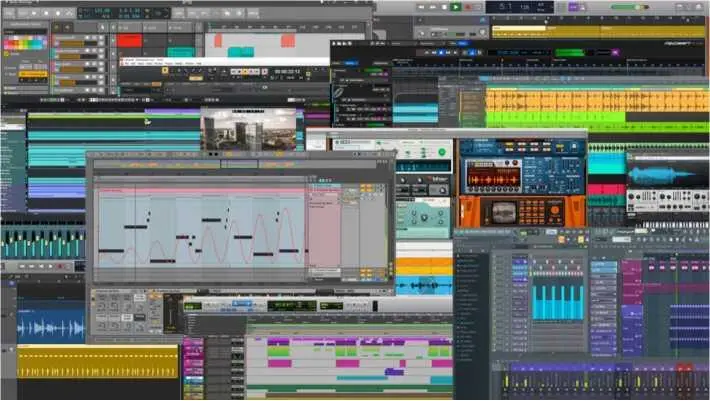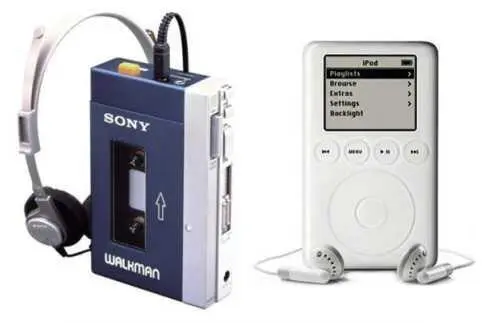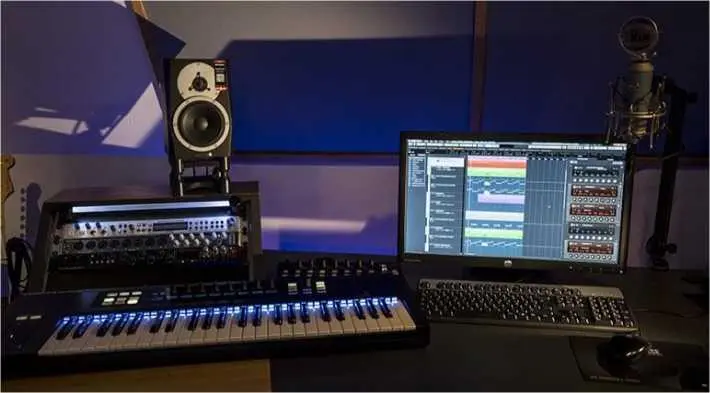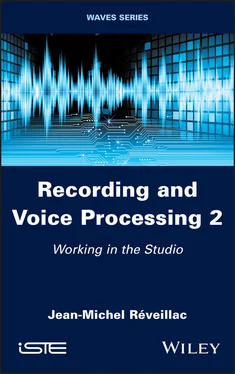A CIP record for this book is available from the British Library
ISBN 978-1-78630-738-5
If you want to know if this book is for you, how it is constructed and organized, what it contains and what conventions will be used, you’ve come to the right place, this is the place to start.
This book is intended for all those who, amateur or professional, are interested in sound recording, recording and mixing in the field of singing and voice or musicians, performers, commentators and composers.
The work presented in some sections requires minimum knowledge in the field of acoustics and digital audio.
You must have a good knowledge of your computer’s operating system (paths, folders and directories, files, names, extensions, copying, moving, etc.) and know how to handle a DAW (Digital Audio Workstation), such as Avid Pro Tools, Apple Logic Pro X, Ableton Live, Steinberg Cubase, FL Studio, MOTU Digital performer, Cockos Reaper, etc., or a digital integrated studio, such as Tascam DP-03SD, Tascam DP32, Roland VS-1680, Akai DPS16HD, Yamaha AW4416, etc.
Structure and contents of the book
This work is composed of two volumes:
1 1) history and generalities;
2 2) studio work.
Volume 1 presents a preface, specifying the contents and the writing conventions used, then an introduction followed by four chapters, a conclusion and five appendices:
– recording history;
– voice;
– microphones;
– acoustic environment.
The conclusion summarizes the main topics discussed and introduces the concepts that will be addressed in the second volume.
Appendices 1–5 provide some additional information. You will find in this order:
– sound unit;
– audio connectivity;
– audio processing plugins;
– tube and JFET mic amplifiers;
– microphone pairs.
Volume 2 presents a preface and an introduction identical to those of Volume 1 followed by four chapters, a conclusion and five appendices:
– processing hardware and software;
– configuration and audio channel;
– voice recording;
– special effects.
Appendices 1–4 are taken from Volume 1 to complement the previous chapters by including:
– sound unit;
– audio connectivity;
– audio processing plugins;
– microphone pairs.
Appendix 5 of Volume 2 provides details on the types of software plugins available from different vendors and operating systems.
The conclusion sheds light on the whole book and gives a brief overview of the future evolution of voice recording.
Each volume can be read separately. While there are concepts that are dependent on another chapter, references to the relevant sections are given. However, the first two chapters of Volume 1, devoted to the history of recording and to the human voice, provide a contextual basis for the understanding of several notions that you will find in the following chapters.
If you’re a novice on the subject, I strongly advise you to read them first, to discover the basics of the subject of this book.
For the others, I hope that you will discover new notions that will enrich your knowledge.
At the end of each volume, you will find a reference list and a list of Internet links.
A glossary is also present; it will explain some acronyms and terminologies very specific to sound recording, recording and mixing.
This book uses the following typographical conventions:
Italics, which are reserved for important terms used for the first time in the text which may be present in the glossary at the end of the book, mathematical terms, comments, equations, expressions or variables.
Remarks are indicated by the presence of the keyword: NOTE. They complete the explanations already provided.
The figures and tables all have a legend that is often useful for understanding.
Vocabulary and definition
As with all techniques, voice recording has its own vocabulary. Certain words, acronyms, abbreviations, initialisms and proper names are not always familiar and will be included in the glossary.
I would especially like to thank the ISTE Ltd team and my editor Chantal Ménascé, who trusted me.
Finally, I would like to thank my wife, Vanna, and my daughters Océane and Léa who supported me throughout the writing of this book.
August 2021
As you may have discovered in Volume 1 of this book, voice recording and voice processing have been around for several decades. During the 20th century, the techniques and means of capture rapidly evolved from an environment that was analog and electromechanical, then electronic, to digital technologies which currently allow an almost systematic dematerialization of the transcription and archiving chain.
The computer and the appearance of digital audio processing stations, mixing editors and processing plugins have become indispensable, imposing new standards.

Figure I.1. Some digital audio workstations (DAWs) –
source: www.musicradar.com . For a color version of this figure, see www.iste.co.uk/reveillac/recording2.zip
The predominance of the Internet and networks has shaken up the entire music industry, from sound recording to distribution to the final customer. The listener has changed their relationship with the broadcasting medium, seeing the disc, the tape, the walkman and soon the CD or even the MP3 disappear, having only a subscription to a streaming platform (Spotify, Deezer, Apple Music, YouTube Music, Amazon Music, etc.).
There are some nostalgists who still defend the vinyl record, which is making a comeback, but it is far from being the most widespread medium. The worldwide invasion of smartphones and the constant evolution of the speed and quality of networks has quickly changed habits, making obsolete many technologies that were considered innovative only a few years ago.

Figure I.2. The first portable tape player (Sony TPS-L2 – 1979) and the MP3 player (Apple iPod – 2002)
In this second volume, more oriented towards recording, voice mixing and studio work, I will start by describing the hardware and software tools that are effective in recording and include them in the audio chain that will support them.
To continue, I will present several examples of recording studio configurations, from the most modest to the most advanced.
In this context, I will approach sound recording, without neglecting the comfort of the performer and the management of their immediate environment, within which will be placed the various essential materials, respecting the rules necessary for a correct recording.

Figure I.3. An example of a home studio – source: thomann.de. For a color version of this figure, see www.iste.co.uk/reveillac/recording2.zip
To go further, I will study the constraints related to the recording of a group, a choir or a voice-over.
Читать дальше















